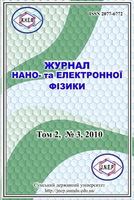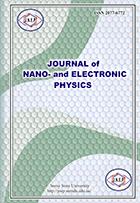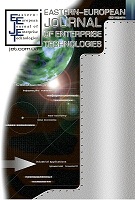
Бази даних
Наукова періодика України - результати пошуку
 |
Для швидкої роботи та реалізації всіх функціональних можливостей пошукової системи використовуйте браузер "Mozilla Firefox" |
|
|
Повнотекстовий пошук
| Знайдено в інших БД: | Реферативна база даних (19) |
Список видань за алфавітом назв: Авторський покажчик Покажчик назв публікацій  |
Пошуковий запит: (<.>A=Kozhitov L$<.>) | |||
|
Загальна кількість знайдених документів : 18 Представлено документи з 1 до 18 |
|||
| 1. | 
Kozhitov L. Influence of Structural Features and Physico-chemical Properties of Metal-carbon Nanocomposites with Ferromagnetic Metal Inclusions on Microwave Radiation [Електронний ресурс] / L. Kozhitov, A. Kuzmenko, D. Muratov, V. Rodionov, A. Popkova, E. Yakushko, M. Dobromyslov // Журнал нано- та електронної фізики. - 2014. - Т. 6, № 3. - С. 03024-1-03024-5. - Режим доступу: http://nbuv.gov.ua/UJRN/jnef_2014_6_3_26 Metal-carbon nanocomposites on the basis of polyacrylonitrile and compounds of metals (Fe, Ni, Co) synthesized at IR-heating and studied by SEM, X-ray phase analysis, Raman scattering, IR Fourier spectroscopy are characterized by the carbon nanostructured amorphous graphite matrix with uniformly distributed nanoparticles of metals (10 - 30 nm), their oxides and compounds - FeNi | ||
| 2. | 
Kozhitov L. V. Features of Formation of the Nanoparticles of Alloys in Metal-carbon Nanocomposites FeCo / C and NiCo / C on Based Polyacrylonitrile [Електронний ресурс] / L. V. Kozhitov, D. G. Muratov, V. G. Kostishin, A. G. Savchenko, I. V. Schetinin, A. V. Popkova, E. V. Yakushko, L. M. Chervjakov // Журнал нано- та електронної фізики. - 2014. - Т. 6, № 3. - С. 03038-1-03038-4. - Режим доступу: http://nbuv.gov.ua/UJRN/jnef_2014_6_3_40 By the method of IR-heating the precursor on base of polyacrylonitrile, compounds of iron, cobalt and nickel metal-carbon nanocomposites were obtained, representing an ensemble of nanoparticles of intermetallic FeCo (NiCo), dispersed in nanocrystalline carbon matrix. XRD analysis revealed that the carbon structure of the PANbased matrix changed from amorphous to nanocrystalline at the processing temperatures in the range <$E200~-~700~symbol Р roman C>. Thus there is a reduction of metals from compounds released by degradation of the polymer with hydrogen. FeCo alloy nanoparticles formed at synthesis temperatures <$ET~>>~500~symbol Р roman C>, in the case of nanocomposites Ni-Co / C alloy nanoparticle formation is possible at <$ET~symbol У~270~symbol Р roman C>, which is associated with a lower temperature compared to the recovery of nickel from iron. According to the results of TGA and DSC found that metals are capable of initiating the chemical transformation in the PAN, resulting in reduction start temperature degradation. According to the results of DSC revealed that the formation of nanoparticles is accompanied by release of heat due to exothermic processes occurring in the nanocomposites. | ||
| 3. | 
Kozhitov L. V. The Structure and Magnetic Properties Metal-carbon Nanocomposites FeCo /C on Based of Polyacrylonitrile [Електронний ресурс] / L. V. Kozhitov, D. G. Muratov, V. G. Kostishin, A. G. Savchenko, I. V. Schetinin, V. A. Tarala, A. V. Popkova, L. M. Chervjakov // Журнал нано- та електронної фізики. - 2014. - Т. 6, № 3. - С. 03039-1-03039-4. - Режим доступу: http://nbuv.gov.ua/UJRN/jnef_2014_6_3_41 For the first time in the conditions of the IR pyrolysis precursor based on polyacrylonitrile, cobalt acetate and acetylacetonate iron (ratio of metals in precursors Fe:Co = 3:1) metal-carbon nanocomposites have been obtained, which are carbon matrix with graphite-like structure, containing buried her nanoparticles of intermetallids of FeCo. It is shown that the phase formation FeCo occurs in the temperature range of obtaining 500 - 600 degrees centigrade, at <$ET~symbol Г ~500> degrees centigrade are only two distinct phases metals: HCC-With and BCC Fe. In the structure of nanocomposites obtained at <$ET~symbol У~600> degrees centigrade, at the same time there are nanoparticles of intermetallides and FeCo little content phase fсс-Co or solid solution of cobalt. It is determined that the composition of a metal component nanocomposite satisfies the ratio of Fe, Co, originally specified.By method of IR-pyrolysis the precursor of polyacrylonitrile and compounds of cobalt and nickel metalcarbon nanocomposites were obtained, representing nanoparticles of alloy NiCo, dispersed in nanocrystalline carbon matrix. Identification of alloy nanoparticles was carried out by the values of the lattice parameter, which was determined by X-ray analysis and was 0,3533 nm (values of the lattice parameter for Ni 0,3529 nm), this corresponds intermetallics Ni | ||
| 4. | 
Kozhitov L. V. The Structure and Magnetic Properties Metal-carbon Nanocomposites NiCo / C on Based of Polyacrylonitrile [Електронний ресурс] / L. V. Kozhitov, D. G. Muratov, S. G. Emelyanov, V. G. Kostishin, E. V. Yakushko, A. G. Savchenko, I. V. Schetinin, E. P. Mosyakina // Журнал нано- та електронної фізики. - 2014. - Т. 6, № 3. - С. 03040-1-03040-3. - Режим доступу: http://nbuv.gov.ua/UJRN/jnef_2014_6_3_42 For the first time in the conditions of the IR pyrolysis precursor based on polyacrylonitrile, cobalt acetate and acetylacetonate iron (ratio of metals in precursors Fe:Co = 3:1) metal-carbon nanocomposites have been obtained, which are carbon matrix with graphite-like structure, containing buried her nanoparticles of intermetallids of FeCo. It is shown that the phase formation FeCo occurs in the temperature range of obtaining 500 - 600 degrees centigrade, at <$ET~symbol Г ~500> degrees centigrade are only two distinct phases metals: HCC-With and BCC Fe. In the structure of nanocomposites obtained at <$ET~symbol У~600> degrees centigrade, at the same time there are nanoparticles of intermetallides and FeCo little content phase fсс-Co or solid solution of cobalt. It is determined that the composition of a metal component nanocomposite satisfies the ratio of Fe, Co, originally specified.By method of IR-pyrolysis the precursor of polyacrylonitrile and compounds of cobalt and nickel metalcarbon nanocomposites were obtained, representing nanoparticles of alloy NiCo, dispersed in nanocrystalline carbon matrix. Identification of alloy nanoparticles was carried out by the values of the lattice parameter, which was determined by X-ray analysis and was 0,3533 nm (values of the lattice parameter for Ni 0,3529 nm), this corresponds intermetallics Ni | ||
| 5. | 
Kosushkin V. G. Crystal Growth Mechanism in" Synthesis-solute-diffusion" Method in Ultrasonic Field [Електронний ресурс] / V. G. Kosushkin, S. L. Kozhitov, S. G. Emelyanov, Yu. N. Parkhomenko, L. V. Kozhitov // Журнал нано- та електронної фізики. - 2014. - Т. 6, № 3. - С. 03042-1-03042-3. - Режим доступу: http://nbuv.gov.ua/UJRN/jnef_2014_6_3_44 Features crystal growth method "synthesis-solute-diffusion" when applied ultrasonic field are considered. Dependence of the crystal optical transmission heterogeneity frequency ultrasonic vibrations determined. System Tests showed that the optimal vibration frequency that provided a homogeneous crystals and permitting the maintenance of the solidification front in a predetermined position with an accuracy of <$Esymbol С~5~%> frequency is 4 MHz <$Esymbol С~5>. Comparison of the optimum frequency ultrasonic vibrations to increase uniformity in the mode of crystals convective transport under the Czochralski method and conditions of diffusive transfer method indicates a significant difference between these frequencies, i.e. character determines the transfer conditions of optimization process. | ||
| 6. | 
Kosushkin V. G. Gallium Arsenide Czokhralski Crystal Growth with High Oscillatory Influences [Електронний ресурс] / V. G. Kosushkin, S. L. Kozhitov, S. G. Emelyanov, Yu. N. Parkhomenko, L. V. Kozhitov // Журнал нано- та електронної фізики. - 2014. - Т. 6, № 3. - С. 03043-1-03043-2. - Режим доступу: http://nbuv.gov.ua/UJRN/jnef_2014_6_3_45 The influence of ultrasound introduced into the melt during the growth of single crystals of gallium arsenide. Ultrasonic vibrations had a frequency of 820 kHz and amplitude of 0,1 - 0,2 micrometer. Found an increase in the homogeneity of impurity distribution of the bands growth without change of the dislocation structure of single crystals. In the simulation result of the ultrasonic wave interaction with the melt in the crucible on the basis of the theory of formation of phases is established that nucleation rate associated with the frequency and amplitude of the ultrasonic vibration acting on the melt. | ||
| 7. | 
Kosushkin V. G. Morphological Features of Gallium Arsenide Crystals Grown at Low-frequency Influences to the Crystallization Front [Електронний ресурс] / V. G. Kosushkin, S. L. Kozhitov, L. V. Kozhitov, Yu. N. Parkhomenko, L. M. Chervjakov // Журнал нано- та електронної фізики. - 2014. - Т. 6, № 3. - С. 03044-1-03044-4. - Режим доступу: http://nbuv.gov.ua/UJRN/jnef_2014_6_3_46 It was found experimentally that on the initial part of crystal the fluctuations with amplitude more than 1 mm leads to break of the capillary column melt and close of growth. The physical significance of this functional relationship for this probably lies in the different orientation of surface tension forces. Regardless of the direction of stretching and an amplitude-frequency characteristics of development process of the power of the octahedral facets increased with increasing growth rate. Accidents on existing ideas are the result of periodic growth, due, for example, the rotation of the crystal in an asymmetric thermal field. When carrying out the method of crystal growth with perturbations at the interface it to a solid phase, the lateral surface is also composed of corrugations distinguishable to the naked eye.In general, the study of structural defects in the crystals obtained in exacting heat conditions, showed that in this case, lowfrequency disturbance of the melt at the interface reduces the average density of dislocations due to the periodic melting of crystallization and partially "heal" the defective portions of the crystals. | ||
| 8. | 
Panina L. V. Effective Impedance Method for In situ Ellipsometry Analysis of Magnetic Films [Електронний ресурс] / L. V. Panina, A. T. Morchenko, L. V. Kozhitov, P. A. Ryapolov // Journal of Nano- and Electronic Physics. - 2013. - Vol. 5, № 4(1). - С. 04003-1-04003-4. - Режим доступу: http://nbuv.gov.ua/UJRN/jnep_2013_5_4(1)__5 The method of effective surface impedance is proposed and applied for in situ characterisation of magnetic structures. For any ellipsometry investigations a proper choice of a physical model is important for solving the inverse problem. Reasonable approximations used for in situ ellipsometry monitoring are assumptions of a constant rate of layer growth and stable optical parameters. Standard ellipsometry analysis requires the model response to be calculated from every layer in the structure. Errors from underlying layers propagate through the entire structure and accumulate. In this case a method of a pseudosubstrate is used which approximates the underlying structure as a single interface (so called virtual interface), rather than tracking the entire sample history. The virtual interface is placed at some level and growth is modelled on this interface with no knowledge retained for the underlying structure. There are various methods for describing the virtual interface. In this paper, the concept of the effective impedance is used which requires only three measurement data points and is convenient for combined investigation of optical and magneto-optical properties. The algorithm is based on the calculation of the characteristic matrix of the layer (Abeles matrix) and surface impedance of the virtual interface using two ellipsometric experimental data points. The method is successfully used to analyse Co/SiCo films. | ||
| 9. | 
Kozhitov L. V. The Synthesis of Metalcarbon Nanocomposite Ni / C on the Basis of Polyacrylonitrile [Електронний ресурс] / L. V. Kozhitov, D. G. Muratov, E. V. Yakushko, S. L. Kozhitov, A. G. Savchenko, I. V. Shchetinin, S. G. Emelyanov, L. M. Chervjakov // Journal of Nano- and Electronic Physics. - 2013. - Vol. 5, № 4(1). - С. 04007-1-04007-4. - Режим доступу: http://nbuv.gov.ua/UJRN/jnep_2013_5_4(1)__9 Metalcarbon nanocomposites based on polyacrylonitrile and nickel chloride are synthesized under the influence of infrared heat. The resulting materials represent a system of carbon matrix formed during the carbonization of PAN, and distributed in it nickel nanoparticles. The average size of the nanoparticles in the nanocomposite was 15 - 25 nm. It was found that the distribution of nickel nanoparticles sizes is determined by temperature synthesis nanocomposite. Thus with increasing temperature, the predominant average particle size of the metal increases, and the distribution is spread and shifted toward larger sizes. | ||
| 10. | 
Kozhitov L. V. Influence of the Ratio of Metal Composed Nanocomposites Fe-Co / C on Phase Composition [Електронний ресурс] / L. V. Kozhitov, A. P. Kuzmenko, S. L. Kozhitov, D. G. Muratov, V. A. Harseev, V. V. Rodionov, A. V. Popkova, K. E. Matveev, E. V. Yakushko // Journal of Nano- and Electronic Physics. - 2013. - Vol. 5, № 4(1). - С. 04008-1-04008-3. - Режим доступу: http://nbuv.gov.ua/UJRN/jnep_2013_5_4(1)__10 It is found that the chemical composition of the metal component of nanocomposites satisfies the Fe:Co ratio, that was set on at the stage of preparation of the precursor, wherein there is a slight deviation from the initial metal concentration, due, apparently, to removing metal from the nanocomposite by the formation of volatile carbonyls of iron and cobalt in IR heating. | ||
| 11. | 
Kozhitov L. V. The Structure and Content Peculiarities of Carbon Material Obtained under the Polyacrylonitrile Infra-red Heating [Електронний ресурс] / L. V. Kozhitov, N.Ch. V’et, V. V. Kozlov, S. G. Emelyanov // Journal of Nano- and Electronic Physics. - 2013. - Vol. 5, № 4(1). - С. 04020-1-04020-3. - Режим доступу: http://nbuv.gov.ua/UJRN/jnep_2013_5_4(1)__22 It is first determined by the semiempirical quantum chemical model MNDO for a carbon material (CM) structure based on polyacrylonitrile (PAN) heat-treated that the increase of a content N from 14 to 18 atoms in CM monolayers C46N14H10, C44N16H12, and C42N18H14 and a content H from 12 to 22 atoms in CM monolayers C44N16H12 and C44N16H22 leads to the decrease of the binding energy (EB) from 7,40; 7,12 to 6,88 and 6,25 eV, respectively; and to the increase of the differences between the maximum and minimum bond lengths (DELTA l), between the maximum and minimum valence angles (DELTA THETA), and between the maximum and minimum local charges (DELTA q) from 0,176 angstram; 12,0o, and 0,487 to 0,238 angstram; 20,8o, and 0,613, respectively, and promotes the CM structure curvature. Quantum chemical simulation results are confirmed by the element analysis of CM samples and a nanocomposite FeNi3/C. As the IR heating temperature is increased from 30 to 500o C, concenrations N (СN) and H (CH) in the CM and nanocomposite FeNi3/C are decreased from 27 to 18 and 10 wt % and from 6 to 1 and 0,5 wt %, respectively. | ||
| 12. | 
Chitanov D. Applying the ltcc-technology to obtain hexaferrites for base layers of microstrip shf devices [Електронний ресурс] / D. Chitanov, V. Kostishyn, L. Kozhitov, A. Adamtsov // Восточно-Европейский журнал передовых технологий. - 2016. - № 5(1). - С. 27-31. - Режим доступу: http://nbuv.gov.ua/UJRN/Vejpte_2016_5(1)__6 За допомогою методу низькотемпературної сумісно обпалюваної кераміки (LTCC - Low Temperature Co-fired Ceramics) одержано зразки ізо- та анізотропних полікристалічних гексаферритів BaFe12O19 і SrFe12O19 для підкладок надмініатюрних мікросмужкових феритових розв'язувальних приладів короткохвильової частини міліметрового діапазону довжин хвиль. Досягнуто ущільнення зразків за 900 °C у процесі спікання з додаванням невеликої кількості Bi2O3 - B2O3 - SiO2 - ZnO. | ||
| 13. | 
Muratov D. G. The Influence of Synthesis Temperature on the Structure, Composition and Magnetic Properties of Nanocomposites NiCo/C [Електронний ресурс] / D. G. Muratov, L. V. Kozhitov, S. G. Emelyanov, E. V. Yakushko, M. F. Bulatov // Журнал нано- та електронної фізики. - 2015. - Т. 7, № 4. - С. 04071-1-04071-4. - Режим доступу: http://nbuv.gov.ua/UJRN/jnef_2015_7_4_73 By method of IR-pyrolysis the precursor of polyacrylonitrile and compounds of cobalt and nickel metalcarbon nanocomposites were obtained, representing nanoparticles of alloy NiCo, dispersed in nanocrystalline carbon matrix. NiCo/C nanocomposites are ferromagnets. Magnetization and the coercive force depends on the size and composition of the alloy nanoparticles NiCo. The average size of metal nanoparticles is determined by the synthesis temperature and in range of 350 - 800 °C is 10 - 80 nm, respectively. According to the results of TEM it was detected that with increasing synthesis temperature the maximum synthesis of nanoparticles size distribution shifts to larger sizes. The magnetization and coercivity depend on the size and composition of the nanoparticles of alloy NiCo. With increasing synthesis temperature from 350 to 800 °C the magnetization increases from 0,055 to 17 A · m2/ kg. | ||
| 14. | 
Kozhitov L. V. The Formation and Study of the FeCo Nanoparticles Alloy in Structure of Metal-Carbon Nanocomposites FeCo/C [Електронний ресурс] / L. V. Kozhitov, M. F. Bulatov, V. V. Korovushkin, V. G. Kostishin, D. G. Muratov, M. N. Shipko, S. G. Emelyanov, E. V. Yakushko // Журнал нано- та електронної фізики. - 2015. - Т. 7, № 4. - С. 04103-1-04103-5. - Режим доступу: http://nbuv.gov.ua/UJRN/jnef_2015_7_4_105 The study of the peculiarities of the formation of the nanoparticles FeCo-alloy in the composition of metal-carbon nanocomposites FeCo/C. Structure, phase composition and kinetic processes of synthesis of nanocomposites FeCo/C by methods of Mossbauer spectroscopy were studied. This allowed us to establish the peculiarities of formation of nanoparticles FeCo alloy in the composition of the nanocomposites. The nanocomposites were synthesized by the IR-pyrolysis at temperatures of precursors of 300 - 800 °C on the basis of polyacrylonitrile (PAN), iron acetylacetonate and cobalt acetate. Also it is established that an increase in the average size of nanoparticles FeCo with increasing temperature synthesis is occurred. In the temperature range of synthesis of 600 - 800 °C the size varies from 9 - 10 to 16 - 18 nm, respectively. The features the phase transitions and phase composition of the metal-carbon nanocomposites FeCo/C were studied by Mossbauer spectroscopy. Nanocomposites were synthesized in the temperature range of T = 300 - 800 °C. It was shown that the samples synthesized at T = 300 °C contains of superparamagnetic nanoparticles of magnetite and amorphous oxide of iron only. The process of forming nanoparticles of alloy FeCo occurs within the temperature range 500 - 600 °C due to the recovery of amorphous iron oxide and magnetite as well as them dissolving in a phase of cobalt. The growth of size of nanoparticles of alloy by agglomeration and dissolution of iron in the alloy nanoparticles occurs only at the temperature range of synthesis 600 - 800 °C. This is confirmed by a decrease of the content of Fe, which associated with carbon and it is consistent with the results of phase and structural studies, carried out in previous works. | ||
| 15. | 
Chitanov D. N. Obtaining Hexagonal Ferrites for Substrates Microstrip Microwave Devices of mm-Range of LTCC-technology [Електронний ресурс] / D. N. Chitanov, V. G. Kostishyn, L. V. Kozhitov, A. Yu. Adamtsov // Журнал нано- та електронної фізики. - 2016. - Т. 8, № 3. - С. 03013-1-03013-4. - Режим доступу: http://nbuv.gov.ua/UJRN/jnef_2016_8_3_15 In the work by the method low temperature co-fired ceramics (LTCC) obtained samples of isotropic and anisotropic polycrystalline hexafemte BaFe12O19 and SrFe12O19. Using in the LTCC-technology the pressing operation for samples (tablets) in a magnetic field produces anisotropic hexaferrites, pressing without a magnetic field - isotropic hexafemtes. Application in the LTCC-technology molding process tape produces exclusively isotropic samples. | ||
| 16. | 
Chitanov D. N. LTCC-technology for Producing Hexaferrites [Електронний ресурс] / D. N. Chitanov, V. G. Kostishyn, L. V. Kozhitov, P. A. Ryapolov, A. Yu. Adamtsov // Журнал нано- та електронної фізики. - 2016. - Т. 8, № 3. - С. 03016-1-03016-6. - Режим доступу: http://nbuv.gov.ua/UJRN/jnef_2016_8_3_18 In the review examined the possibility of using LTCC-technology for obtaining hexafemtes as reaction additives glasses Bi | ||
| 17. | 
Muratov D. G. Synthesis of Nanoparticles of Fe-Co-Ni Three-component Alloy Capsulated into Carbon Matrix of Fe-Co-Ni/C Nanocomposites [Електронний ресурс] / D. G. Muratov, L. V. Kozhitov, S. G. Emelyanov, A. V. Vasilyev, A. V. Popkova, A. A. Pavlova // Журнал нано- та електронної фізики. - 2016. - Т. 8, № 3. - С. 03037-1-03037-3. - Режим доступу: http://nbuv.gov.ua/UJRN/jnef_2016_8_3_39 Nanoparticles of Fe - Co - Ni three-component alloy capsulated into carbon matrix were synthesized. Structure, phase composition and magnetic properties of obtained materials were defined by diffractometry and magnetometry. It was established that composition of nanoparticles is determine by synthesis temperature, because nanoparticles of three-component alloy are forms by dissolution of cobalt in Fe - Ni alloy. Magnetization of Fe - Co - Ni/C nanocomposites and coercive force increases from 26 up to 58 A · m2/ kg during temperature increase that relates with growth of particles size and increase of cobalt content in the alloy. | ||
| 18. | 
Kosushkin V. G. The Micro and Nano- Defects Formation during Czochralski Growth [Електронний ресурс] / V. G. Kosushkin, L. V. Kaplunov I. A. Kozhitov // Журнал нано- та електронної фізики. - 2016. - Т. 8, № 3. - С. 03054-1-03054-3. - Режим доступу: http://nbuv.gov.ua/UJRN/jnef_2016_8_3_56 | ||
 |
| Відділ наукової організації електронних інформаційних ресурсів |
 Пам`ятка користувача Пам`ятка користувача |